Tourism at the time in Puy-en-Velay |

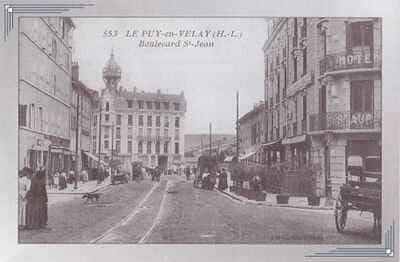 Situated about 3 km from the left bank of the Loire, between the Borne and the Dolaison, it leans against the southern slope of an isolated hill, Mount Anis, from which emerges the gigantic Corneille rock, crowned since 1860 by a colossal statue of the Virgin. This hill occupies the center of a vast circus, surrounded by mountains, which takes on an impressively original character due to the strange volcanic rocks emerging from all sides: to the North, Aiguilhe and its Saint-Michel church, Polignac and its keep; to the West, Espaly where a huge statue of St. Joseph stands, Arbouisset, Ceyssac.
Situated about 3 km from the left bank of the Loire, between the Borne and the Dolaison, it leans against the southern slope of an isolated hill, Mount Anis, from which emerges the gigantic Corneille rock, crowned since 1860 by a colossal statue of the Virgin. This hill occupies the center of a vast circus, surrounded by mountains, which takes on an impressively original character due to the strange volcanic rocks emerging from all sides: to the North, Aiguilhe and its Saint-Michel church, Polignac and its keep; to the West, Espaly where a huge statue of St. Joseph stands, Arbouisset, Ceyssac.
The old town or holy city, famous for its pilgrimage, displays its red roofs and terraced alleys, with an extremely curious archaic appearance, at the foot of its magnificent Romanesque cathedral. The modern districts, wide and airy, extend in the plain around the vast Place du Breuil, the lively center of the city, which is at an altitude of 625 m, while the platform of the Corneille rock reaches 755 m.
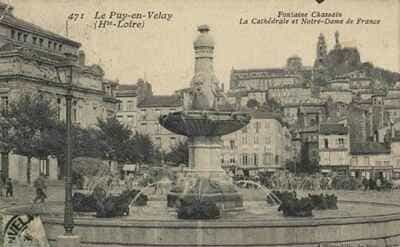 Puy-en-Velay, which has good hotels, is an excellent tourism center and one of the classic stops between Paris and the Mediterranean south. Railway (s.n.c.f.): Puy-en-Velay is connected to Paris by three lines: via Saint-Etienne (590 km), via Vichy (536 km), or via Clermont-Ferrand (567 km).
Puy-en-Velay, which has good hotels, is an excellent tourism center and one of the classic stops between Paris and the Mediterranean south. Railway (s.n.c.f.): Puy-en-Velay is connected to Paris by three lines: via Saint-Etienne (590 km), via Vichy (536 km), or via Clermont-Ferrand (567 km).
Car services (departing from Place Michelet): for Yssingeaux and Saint-Etienne; Yssingeaux, Tence, Saint-Bonnet-en-Velay, Lalouvesc, and Annonay; Saint-Agrève; Saint-Julien-Chapteuil and Fay-sur-Lignon; Laussonne; Le Monastier sur Gazeille; Landos, Pradelles, and Langogne; Cayres, Le Bouchet St Nicolas, Chapeauroux, and Chambon-le-Gâteau; Monistrol d'Allier, Saugues, Le Malzieu, and Saint-Chély-d'Apcher; Siaugues and Langeac; Brioude; Blanzac and Saint-Paulien; Allègre, Sembadel-Gare, and La Chaise-Dieu; Craponne; etc.
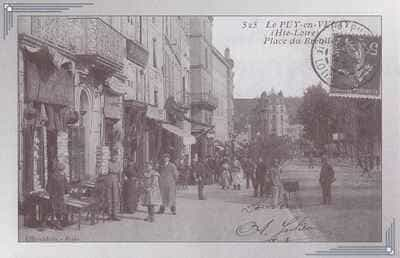 Hotels:
Hotels:
Hotel Bristol and Lyonnaise Tavern, 7 av. Maréchal-Foch (40 rooms; tel. 13-38).
Hotel Regina, 34 bd Maréchal-Fayolle (45 rooms; tel. 14-71).
Grand Hotel La / ayettc, 17 bd Saint-Louis (37 rooms; tel. 2-21).
Hotel du Cygne, 47 bd Maréchal-Fayolle (30 rooms; tel. 0-88).
Hotel Terminus, in front of the station (40 rooms; tel. 13-60).
Hotel du Parc, 4 bd Alexandre-Clair, in front of the Vinay garden (35 rooms; tel. 1-44).
Hotel du Velay, 5 av. Charles-Dupuy (14 rooms; tel. 5-81).
Restaurants:
Café de Paris Restaurant, 33 pi. du Breuil (tel. 2-37).
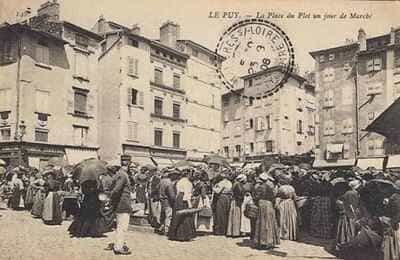 Lyonnaise Tavern Restaurant, 7 av. Maréchal-Foch (tel. 5-42).
Lyonnaise Tavern Restaurant, 7 av. Maréchal-Foch (tel. 5-42).
Poste Restaurant, 53 bd Saint-Louis (tel. 3-75).
Petit-Vatel Restaurant, 6 pi. Michelet (tel. 10-08).
Cafés:
Place du Breuil.
Post Office:
Av. Charles Dupuy (PI. D3).
Taxi-autos:
At the station and Place du Breuil.
Tourist coaches:
Organized tours by the Tourist Office during the season: La Chaise-Dieu, Mézenc, Gerbier-de-Jonc, lakes of Issarlès and Bouchet, Vais, Vallon, Pont d'Arc, Aven d'Orgnac.
Entertainment and sports:
Municipal theater, Place du Breuil; 4 cinemas; tennis; fishing.
Specialties:
Lace; liqueurs of Velay: verbena, gin, sloe; green lentils.
Tourist Office and Velay Initiative Association:
Hall of the theater, Place du Breuil (open every day; information; booking places for coach tours; reading room; tel. 11-88).
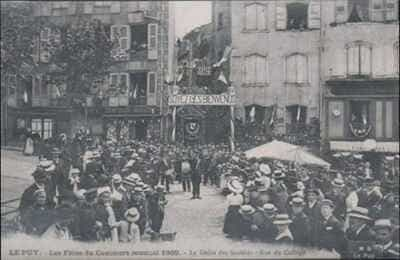 Industries:
Industries:
The main industry, not only of Puy but of all Velay, is represented by the home production of lace and bobbin lace, generally made of linen, wool, silk, and gold and silver threads. This craft has persisted since the 14th century and has consistently been the traditional work of the women of Velay; it once employed about 70,000 women but has been declining since 1914 due to the exodus of young girls and mechanical competition.
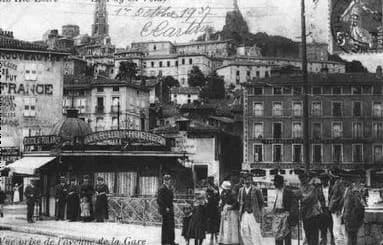 Lace makers, seated on low chairs, keep the bobbin lace-making tool, the pillow, resting on their laps; they enjoy working together, in winter at the home of the best-off among them, and in summer in the shade of a wall. The groups they form, called semblées or couviges, give the villages of the Puy-en-Velay region one of their most characteristic appearances during the beautiful season.
Lace makers, seated on low chairs, keep the bobbin lace-making tool, the pillow, resting on their laps; they enjoy working together, in winter at the home of the best-off among them, and in summer in the shade of a wall. The groups they form, called semblées or couviges, give the villages of the Puy-en-Velay region one of their most characteristic appearances during the beautiful season.
In Puy-en-Velay itself, many lace makers can be seen working, notably on Rue des Tables and behind the cathedral. Puy-en-Velay is also a major center for machine-made lace, veils, nets, trimmings, and hosiery. The city has significant distilleries for liqueurs. It has a considerable market for dried vegetables, especially lentils.
In the 1st century AD, the land of the Vellaves had its capital at Ruessio or Revessium (now Saint-Paulien), which had a bishopric by the end of the 3rd century or, more likely, in the 4th century. The Amcium mentioned by Gregory of Tours must have gained or retained some importance due to its military position next to Revessio. Thus, the bishops were compelled by invasions to transfer their seat there in the 6th century. The new capital of Velay (Podium Aniciense, the Puy of Anis) soon gained extraordinary fame and great prosperity due to the pilgrimage centered at its cathedral. This pilgrimage to the Black Virgin of Puy was, throughout the Middle Ages, the most famous in France alongside those of Chartres and Boulogne. Among the popes and kings who visited were: Urban II, Innocent II, Charlemagne, Philip Augustus, St. Louis, Charles VI, Charles VII, Louis XII, and Francis I.
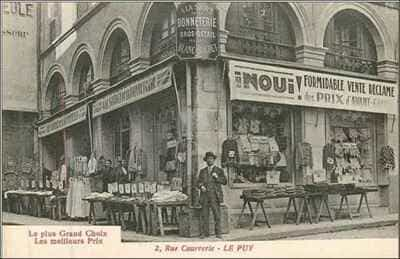 At the beginning of the feudal era, Velay was part of the duchy of Guyenne; however, in 1162, William of Auvergne, who was count of Puy, mistreated the bishop and was dispossessed by the king of his county in favor of the bishop, who thereafter lived under the king's protection. This operation, along with a similar one carried out in Mende for the county of Gévaudan, allowed the Crown to establish contact with the Occitan-speaking regions before the Albigensian Crusade.
At the beginning of the feudal era, Velay was part of the duchy of Guyenne; however, in 1162, William of Auvergne, who was count of Puy, mistreated the bishop and was dispossessed by the king of his county in favor of the bishop, who thereafter lived under the king's protection. This operation, along with a similar one carried out in Mende for the county of Gévaudan, allowed the Crown to establish contact with the Occitan-speaking regions before the Albigensian Crusade.
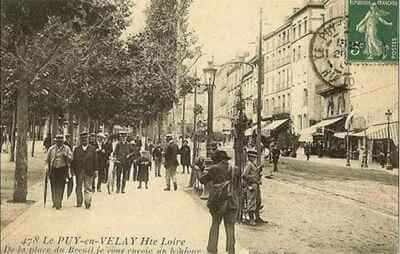 In 1307, Philip the Fair completed Louis VII's work by signing a treaty of co-lordship with the bishop-count, making him co-lord of Velay. The bishops also had to struggle against communal claims. During the Hundred Years' War, the city remained loyal to the King of France and later, when the nearby Cévennes embraced Protestantism, it resisted attacks from the Reformed, sided with the League in 1588, and only recognized Henry IV after his abjuration.
In 1307, Philip the Fair completed Louis VII's work by signing a treaty of co-lordship with the bishop-count, making him co-lord of Velay. The bishops also had to struggle against communal claims. During the Hundred Years' War, the city remained loyal to the King of France and later, when the nearby Cévennes embraced Protestantism, it resisted attacks from the Reformed, sided with the League in 1588, and only recognized Henry IV after his abjuration.
In 1944, Puy-en-Velay was liberated by the Lafayette group of the F.F.I. The German garrison, attacked on August 18 at 9 PM, surrendered on Saturday, August 19 at 4 PM.
Puy-en-Velay has seen the birth of several notable figures, including Cardinal de Polignac (1661-1742); General Mouton-Duvernet (1769-1816); sculptor-founder Charles Crozatier (1795-1855); writer Jules Vallès (1833-1885); Dr. Chantemesse (1851-1919); Marshal Fayolle (1852-1928), who commanded the reserve army group that halted the major German offensives in March and May 1918.
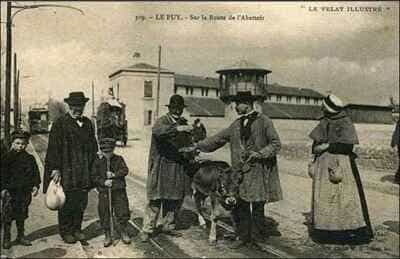 A complete visit to Puy takes a whole day. The old town can only be visited properly on foot. A stroll through its alleys in the moonlight will leave unforgettable impressions. However, it is possible to drive to the cathedral and then go directly from the cathedral to Aiguilhe, still by car. Motorists can leave their car at the Place du Greffe, from where they can visit the cathedral, the cloister, and the Corneille rock on foot.
A complete visit to Puy takes a whole day. The old town can only be visited properly on foot. A stroll through its alleys in the moonlight will leave unforgettable impressions. However, it is possible to drive to the cathedral and then go directly from the cathedral to Aiguilhe, still by car. Motorists can leave their car at the Place du Greffe, from where they can visit the cathedral, the cloister, and the Corneille rock on foot.
The modern city and the museum. From the station, one descends to the Place du Breuil via Avenue Charles-Dupuy and Boulevard du Maréchal-Fayolle. At the bottom of the first street, one sees on the left the new post office and next to it, the Saint-Pierre church, an old Carmelite church from the 14th or 15th century, whose aisles were added later and the façade redone in the 19th century. Behind the church, a small public garden has been created on the site of the old Carmelite cemetery. In front, one crosses the Dolaison on a picturesque old bridge, and joins Boulevard du Maréchal-Fayolle leading to Place du Breuil.
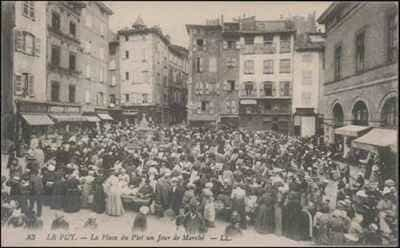 Place du Breuil, the vital center of the city, is a large esplanade planted with trees and decorated in the center with a monumental fountain raised in 1857 through the generosity of the sculptor-founder Crozatier: it is adorned with four large statues representing the Loire, the Allier, the Borne, and the Dolaizon, and below them, four groups of genies, bronze by Bosio the nephew. The southern side of the square is bordered by the Prefecture, behind which extends the Vinay garden. On the eastern side, the theater and the courthouse separate Place du Breuil from Place Michelet.
Place du Breuil, the vital center of the city, is a large esplanade planted with trees and decorated in the center with a monumental fountain raised in 1857 through the generosity of the sculptor-founder Crozatier: it is adorned with four large statues representing the Loire, the Allier, the Borne, and the Dolaizon, and below them, four groups of genies, bronze by Bosio the nephew. The southern side of the square is bordered by the Prefecture, behind which extends the Vinay garden. On the eastern side, the theater and the courthouse separate Place du Breuil from Place Michelet.
To the south of Breuil, behind the Prefecture, lies the Vinay garden, a pleasant public walk shaded by beautiful trees. Here you can see: a Roman portal from a priory in Vorey; a fish farming establishment; the monument to the children of Haute-Loire who died for their country; the monument to Charles Dupuy, a politician (1851-1923). At the far end of the garden rises the museum, in front of which a monument was erected in memory of Charles Crozatier (1795-1855), the work of Barthélémy.
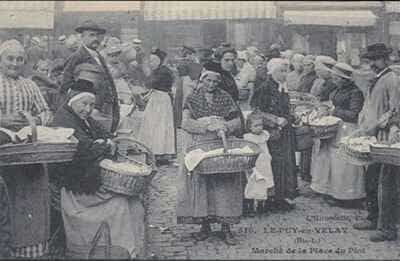 The Crozatier Museum, founded in 1820 by the Viscount de Becdelièvre and transferred to its current location in 1851, occupies a large building considerably expanded in 1868 thanks to a donation from the sculptor-founder Crozatier, born in Puy-en-Velay. Major works affecting part of the main structure and the entire interior layout were necessary from 1947 to 1949. The collections, unexpectedly significant in this austere region, have been reclassified, and their presentation completely renewed according to the principles of modern museography, with the assistance of the curator, Mr. R. Gounot. The newly renovated museum reopened to the public on July 14, 1949.
The Crozatier Museum, founded in 1820 by the Viscount de Becdelièvre and transferred to its current location in 1851, occupies a large building considerably expanded in 1868 thanks to a donation from the sculptor-founder Crozatier, born in Puy-en-Velay. Major works affecting part of the main structure and the entire interior layout were necessary from 1947 to 1949. The collections, unexpectedly significant in this austere region, have been reclassified, and their presentation completely renewed according to the principles of modern museography, with the assistance of the curator, Mr. R. Gounot. The newly renovated museum reopened to the public on July 14, 1949.
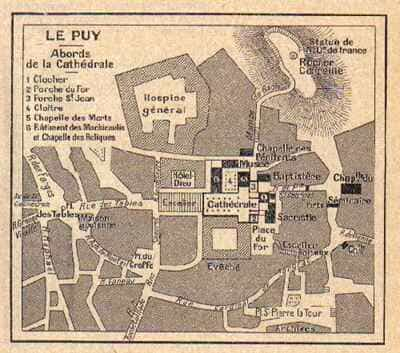 Ground floor.
Ground floor.
The entrance hall is decorated with Aubusson tapestries from the 16th and 17th centuries. You can see portraits of the curators and benefactors of the museum. At the back, the sculpture hall opens.
Sculpture hall from the 18th and 19th centuries. This room is mainly dedicated to the memory and works of sculptors Pierre Julien (1731-1804), born in Saint-Paulien, and Badiou de la Tronchère. Additionally: bust of Napoleon, marble by Canova; works by Cubizolle, Detaplanche, and Oudin.
On the left and right, five rooms of local history are presented in chronological order. The first, very large, houses collections of paleobotany, paleontology, prehistory, and protohistory: notably the remains of fossil humans discovered at the Denise volcano, still preserved in their matrix, which count among the oldest known remains of "homo sapiens fossilis." The second room is dedicated to the local Gallo-Roman period: architectural fragments from major monuments (capitals, friezes), cippi, milestone columns, sarcophagi. The third room covers the origins of Christianity to the end of the Middle Ages: tombs of the first bishops of Puy-en-Velay; important pre-Roman, Roman, and Gothic stone fragments from monuments in the region, especially from the cathedral; considerable documentation details the ancient aspects of this edifice and includes, thanks to a recent donation, the survey of almost all the frescoes destroyed in the 19th century. The fourth room spans from the Renaissance to the Revolution (precious mementos of Lafayette, who originated from the region), and the fifth from the Revolution to the present day.
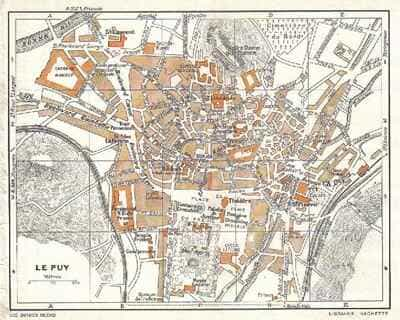 Mezzanine.
Mezzanine.
Rooms of local popular art and ethnography: Peasant objects presented in a beautiful set of woodwork from a village in Velay; objects carved with knives; straw objects; playing cards with their boards; locally made jewelry from the 18th and 19th centuries; engraved or repoussé copper mullet plates with proverbs, 18th century; mule harness, late 18th century; tinware; local glassware (Margeride, Doulon); Orzilhac earthenware (1770-1810); — large lace pillow (500 bobbins); curious collection of carved wooden plates for winding lace, 17th, 18th, and 19th centuries; half-aune for measuring lace; chaleil and bottle of lace makers (the bottle, filled with water, was used to concentrate the light from the chaleil on the work).
A rich series of objects from the 15th century to the present day recalls either the importance of the pilgrimage to Puy-en-Velay (pilgrimage signs, ancient images of the Black Virgin) or religious life (portraits of St. Francis Regis, Mother Agnès of Langeac).
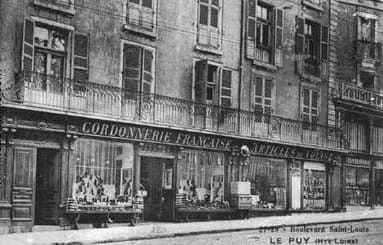 Room of Laces: — a magnificent collection, perfectly presented in illuminated showcases, tracing the history of lace in chronological order; needle lace from the 15th to the 19th centuries, and bobbin lace from the 16th century to the present; pieces of great rarity; bodice of Empress Marie-Louise. The technique and use are presented in the central showcase.
Room of Laces: — a magnificent collection, perfectly presented in illuminated showcases, tracing the history of lace in chronological order; needle lace from the 15th to the 19th centuries, and bobbin lace from the 16th century to the present; pieces of great rarity; bodice of Empress Marie-Louise. The technique and use are presented in the central showcase.
On the stairs: — Jacopo Vignali (Florentine, 1592-1664), Abraham Receiving the Angels; J.-Fr. de Troy, Jason Taming the Bulls.
First Floor.
Room of furniture and art objects from the Middle Ages: — Pietà, tapestry with the arms of Polignac and Pompadour, early 16th century; Gothic pulpit with the arms of Polignac; large chest with the arms of Jean de Bourbon, bishop of Puy-en-Velay (1443-1485); Gothic chests and cathedrals; Virgin and Child, marble, 14th century; wooden statues; — two reliquaries and custodia in Limoges enamel, 12th-13th centuries; Christ in champlevé enamel, 12th century; oliphant in ivory, Moorish art, 12th century; two bronze lion heads, 12th century, from the For gate at the cathedral; small bronzes from the 13th and 14th centuries; Virgin and Child, wooden statuette, 13th century; head of the tomb effigy of Pons de Polignac, marble, 14th century; tomb mask, marble, late 15th century; mourning statuette, marble, early 15th century; marble group from a tomb (14th century), possibly that of Clement VI at La Chaise-Dieu, by Jean de Sanholis, in which case the figures would be the pope's sister, Alinorda, and his children; head of a saint, polychrome stone, early 16th century; head of Christ, school of the South, 16th century; St. Lawrence on the grill, miniature, 15th century; crucifix, processional cross, copper reliquary, bronze candlesticks, wooden comb, from the 15th century; engraved iron cassock, lock entrance, 15th century; stone flask depicting Louis XII.
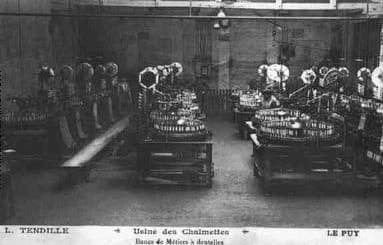 Room of furniture and art objects from the 16th, 17th, and 18th centuries (in the center), where one enters through a beautiful door drum from the old chapel of the Visitation (circa 1750): — Aubusson tapestries, 16th and 17th centuries; credenza with Auvergne decoration, late 15th century; Renaissance seats; large chest from the 16th century; Italian-style cabinet and Lyonnais two-body furniture, late 16th century. Collection of Limoges enamels, including a superb portrait of a woman attributed to Léonard Limozin, and a beautiful Pietà from the 15th century that Marquet de Vasselot considers one of the types of violet enamels. Italian and Lyonnaise earthenware from the 16th century.
Room of furniture and art objects from the 16th, 17th, and 18th centuries (in the center), where one enters through a beautiful door drum from the old chapel of the Visitation (circa 1750): — Aubusson tapestries, 16th and 17th centuries; credenza with Auvergne decoration, late 15th century; Renaissance seats; large chest from the 16th century; Italian-style cabinet and Lyonnais two-body furniture, late 16th century. Collection of Limoges enamels, including a superb portrait of a woman attributed to Léonard Limozin, and a beautiful Pietà from the 15th century that Marquet de Vasselot considers one of the types of violet enamels. Italian and Lyonnaise earthenware from the 16th century.
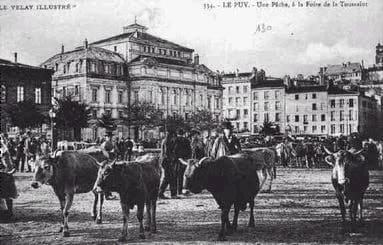 Room of Old Paintings: — School of Siena (late 14th century), Virgin with Bird attributed to Taddeo di Bartolo; Jacobello del Flore (attributed), Virgin on Throne; Vittorio Crivelli (attributed), Two Saints; French School (circa 1420), Virgin with Mantle; Italian School (15th century), Two Saints; Cerquozzi, Battle; — Rhenish School (1497), The Virgin's Family; Albert Dürer (attributed), Peasant at Market, drawing; — Flemish School (early 16th century), The Virgin's Family; Van Dyck School, the Weeping Christ; portrait of Jan Wildens; Frans Francken (attributed), The Painter and His Family; Spranger, Christ and Mary Magdalene; Craesbeeck, portrait, Gueux; Van Païens, The Departure for the Hunt; Van der Werff (attributed), Henriette-Marie of France; portraits by Miereveld, N. Mais, Terborgh; — Kibera (attributed), The Death of Cato; — French School (early 17th century), The Departure of the Prodigal Son; French School (16th century), The Four Ages of Life; Claude Vignon (attributed), A Concert; J.-B. Pierre, Bacchanale; French School (16th century), Portrait of a Woman; Mathieu Le Nain, Portrait of a Man; Augustin Quesnel (attributed), Portrait of a Man; P. Mignard, Portrait of a Duchess of Savoy; La Clementina, A Marshal of France; Tocqué (attributed), Portrait.
Room of Old Paintings: — School of Siena (late 14th century), Virgin with Bird attributed to Taddeo di Bartolo; Jacobello del Flore (attributed), Virgin on Throne; Vittorio Crivelli (attributed), Two Saints; French School (circa 1420), Virgin with Mantle; Italian School (15th century), Two Saints; Cerquozzi, Battle; — Rhenish School (1497), The Virgin's Family; Albert Dürer (attributed), Peasant at Market, drawing; — Flemish School (early 16th century), The Virgin's Family; Van Dyck School, the Weeping Christ; portrait of Jan Wildens; Frans Francken (attributed), The Painter and His Family; Spranger, Christ and Mary Magdalene; Craesbeeck, portrait, Gueux; Van Païens, The Departure for the Hunt; Van der Werff (attributed), Henriette-Marie of France; portraits by Miereveld, N. Mais, Terborgh; — Kibera (attributed), The Death of Cato; — French School (early 17th century), The Departure of the Prodigal Son; French School (16th century), The Four Ages of Life; Claude Vignon (attributed), A Concert; J.-B. Pierre, Bacchanale; French School (16th century), Portrait of a Woman; Mathieu Le Nain, Portrait of a Man; Augustin Quesnel (attributed), Portrait of a Man; P. Mignard, Portrait of a Duchess of Savoy; La Clementina, A Marshal of France; Tocqué (attributed), Portrait.
Room of 18th and 19th century paintings: — portraits from the 18th century; canvases by Huet, Diaz, Guillaumin, Trouillebert, Becdelièvre; Charles Cottet (born in Puy, 1863-1925), Burial in Brittany. — Fight of a Centaur and a Lapith, original bronze by Barye.
On the upper floor, general ethnography and natural history unfold. This includes a section of regional fauna that is fairly complete and rich in very rare specimens, hunted in Haute-Loire, for example, a European lynx shot in Saint-Julien-Chapteuil in 1823. The museum has significant reserves. It notably possesses extensive documentation on lace and a rich collection of numismatics.
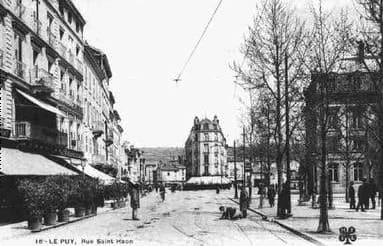 The old town. — Visiting the old town, which is very steep and crisscrossed with terraced alleys that misleadingly bear the name of streets, is somewhat arduous; however, it is essential to do so on foot.
The old town. — Visiting the old town, which is very steep and crisscrossed with terraced alleys that misleadingly bear the name of streets, is somewhat arduous; however, it is essential to do so on foot.
From Place du Breuil, one enters the old town via Rue Porte-Aiguière, which leads to Place du Martouret: at the center, the lime tree of victory, planted on July 14, 1919. To the left rises the town hall from the 18th century, with a staircase and wrought-iron balcony (1762).
Turning your back to the town hall, take Rue Chaussade, then the first street on the left, Rue du Bessat, one of those typical streets that climb directly up the slopes of Corneille rock: this street is bordered on the right by the lycée, an old Jesuit college, whose chapel, begun in 1607, has become the church of Saint-François-Régis.
The façade has a Doric colonnade. Inside, the tribune rests, as in the Jesuit chapel of Rodez, on curious false ogival wooden vaults with decorative paintings from the time; the main altar has a grand and elegant gilded wooden retable framing a Crucifixion by the painter François Guy (Francisco Guido) from Puy-en-Velay, 1619; in the transepts, other beautiful altarpieces with two fine paintings: Nativity and Apparition of the Virgin to St. Francis. Restored frescoes in the choir.
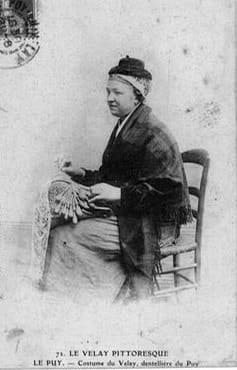 Turning your back to the façade of the church, take Rue du Collège (at No. 22, house from 1660; at No. 2, house from the early 16th century) and cross back over Place du Martouret to take, to the right of the town hall, Rue Courrerie (at No. 8, pretty late Renaissance façade). This street ends at Place du Plot, in the middle of which is a large 18th-century fountain adorned with tritons, whose layout recalls the fountains of the Middle Ages.
Turning your back to the façade of the church, take Rue du Collège (at No. 22, house from 1660; at No. 2, house from the early 16th century) and cross back over Place du Martouret to take, to the right of the town hall, Rue Courrerie (at No. 8, pretty late Renaissance façade). This street ends at Place du Plot, in the middle of which is a large 18th-century fountain adorned with tritons, whose layout recalls the fountains of the Middle Ages.
Crossing the square, one takes Rue Pannessac, which retains interesting houses: No. 18 and 22 from 1771; No. 33 from 1650; No. 42 late 16th century; No. 46 early 17th century; No. 51 from 1576, one of the prettiest houses in Puy-en-Velay; No. 57, the birthplace of Professor Chantemesse (1851-1919), inventor of the antityphoid vaccine.
One goes back a little on Rue Pannessac to take the left onto Rue du Chamarlenc, at No. 18 of which is the curious house from 1689, known as the Cornards, with its two comical masks (the cornards had the privilege of playing big pranks on their fellow citizens). At the narrow end of Rue du Chamarlenc, take the left onto Rue Raphaël: No. 23 from 1770; No. 56 from the Renaissance.
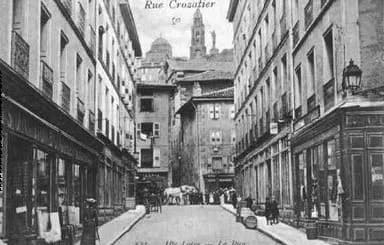 This brings us to Place des Tables: opposite, a large stone gabled house with a 15th-century door (gothic corridor and courtyard), at the corner of Rue des Farges (No. 24 from 1631). Higher up, to the right, the square is adorned with a 15th-century fountain: next to it, a pretty Gothic-Renaissance house at the entrance of Rue Adhémar-de-Monteil (No. 18).
This brings us to Place des Tables: opposite, a large stone gabled house with a 15th-century door (gothic corridor and courtyard), at the corner of Rue des Farges (No. 24 from 1631). Higher up, to the right, the square is adorned with a 15th-century fountain: next to it, a pretty Gothic-Renaissance house at the entrance of Rue Adhémar-de-Monteil (No. 18).
From the square, the picturesque Rue des Tables, dominated at a prodigious height by the façade of the cathedral, rises so steeply that its sidewalks are in steps: in summer, one sees lace stalls and lace makers working on their doorsteps. This leads to the foot of the grand staircase that continues under the porch of the cathedral.
To the left of the staircase rises the Hôtel-Dieu, an ancient foundation that retains a Gothic building with two floors, featuring a very beautiful flamboyant façade facing the staircase: the ground floor serves as a chapel, with two beautiful Romanesque portals (shown below); on the first floor, a large hall from the late 12th century vaulted with ogives. Behind this building and partially masked by it, one can see the building of the Machicoulis.
To the left of the Hôtel-Dieu, Rue de Becdelièvre ends at the General Hospice (1687), facing the chapel built by Portai in 1752, with a beautiful door sculpted by Vaneau. Downhill, to the left, a charming chapel of the Visitation (18th century). Conversely, going up to the right, one reaches a vaulted ogival porch, under which are the two Romanesque portals of the Hôtel-Dieu: one of them is flanked by two curious capitals depicting a figure distributing bread to the poor and four figures caring for a bedridden sick person. Continuing up the picturesque alleyway that passes under the porch, one would arrive at the chapel of the Penitents, at the foot of Corneille rock.
Former holiday hotel with a garden along the Allier, L'Etoile Guest House is located in La Bastide-Puylaurent between Lozere, Ardeche, and the Cevennes in the mountains of Southern France. At the crossroads of GR®7, GR®70 Stevenson Path, GR®72, GR®700 Regordane Way, GR®470 Allier River springs and gorges, GRP® Cevenol, Ardechoise Mountains, Margeride. Numerous loop trails for hiking and one-day biking excursions. Ideal for a relaxing and hiking getaway.
Copyright©etoile.fr